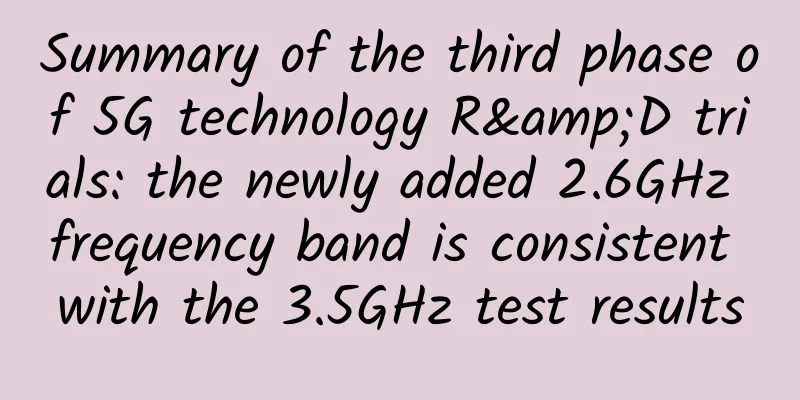Summary of the third phase of 5G technology R&D trials: the newly added 2.6GHz frequency band is consistent with the 3.5GHz test results

|
On January 23, 2019, the IMT-2020 (5G) Promotion Group held a summary meeting of the third phase of 5G technology R&D trials and the launch meeting of the second "Blooming Cup" 5G application collection competition in Beijing. Representatives from major companies, operators, and key vertical industries in the fields of systems, chips, terminals, and instruments from home and abroad attended the meeting. Xu Fei, deputy chief engineer of the Institute of Technology and Standards of the China Academy of Information and Communications Technology, summarized the third phase of 5G technology R&D trials on behalf of the IMT-2020 (5G) Promotion Group. Xu Fei said that according to the schedule, the indoor and outdoor tests of the SA architecture have been completed in the fourth quarter of 2018, and the 5G typical application test has been started. The terminal test and interoperability test will be started in 2019. The test content will be carried out in an orderly manner in the order of single device first, then interoperability, and indoor first, then outdoor. The overall results of the third phase of testing were in line with expectations The main test contents of the third phase of 5G technology research and development tests are non-independent networking, independent networking, indoor distribution, 2.6GHz, etc. Most of the third phase of the 5G technology R&D test specification system has been completed, and the remaining part will be further studied in the future. On the core network side, the voice over NR test method will be formulated; on the base station side, the millimeter wave base station function technical requirements and test methods will be formulated; on the terminal side, the terminal performance test method, millimeter wave terminal equipment technical requirements test method, low-frequency terminal equipment technical requirements (uRLLC), low-frequency terminal equipment test method (uRLLC), etc. will be formulated. In terms of network construction, the 5G technology R&D test built an integrated indoor and outdoor network. The promotion team built more than 70 base stations in the MTNeT laboratory + Huairou field, which is the world's most complete 5G indoor and outdoor integrated test network. A 5G RF conduction test OTA test system was built to fully support the Sub-6GHz frequency band. The promotion team summarized the results of the third phase of NSA testing. Five systems completed the EPC system testing that supports the NSA architecture.
The third phase of SA testing is progressing smoothly. Huawei and ZTE have completed independent network testing; Ericsson and China Information and Communications Technology have completed core network function and performance, security, base station function and field network testing; Nokia Bell has completed more than half of the core network function and field network testing, and has basically completed the base station function testing. Summary of the results of the third phase SA indoor test The promotion team announced the results of the 5GC core network function test. All four systems have completed the core network function test, and the overall results are good. Support the basic functions and new features of the 5G core network. Basic functions include mobility management, IPv4v6 sessions, switching and inter-system interoperability, and the interface protocol meets the version requirements; new features include service-oriented architecture, edge computing, basic functions of network slicing, CU separation, etc. Problems and optimization suggestions found in the test: The allocation and management of IPv6 addresses, slice identifiers, service-oriented callback interfaces, etc. are customized by each system and need to be uniformly defined later; optimize user registration delay; verify the service-oriented interface. The third phase of SA indoor testing built an encircling test system based on a virtualized 5G core network.
The promotion team announced the results of the third phase of SA indoor core network performance testing. 5GC control plane performance: Each system completes the performance test of the main business processes of the 5GC control plane. The control plane based on virtualization deployment has good business scalability and high resource utilization, and has advantages in deployment flexibility. The management virtual machine resources generally have a large margin, and further consideration can be given to the balance and optimization of business performance and resource usage. 5GC user plane performance: Each system completed the 5GC user plane performance test, mainly using the DPDK+SR-IOV acceleration solution. The throughput of a single server with dual 40G network cards can reach 66.4Gbps. The forwarding performance of general servers is subject to factors such as network card specifications, unit CPU forwarding capabilities, and the number of CPU cores. The promotion team announced the base station functions of the third phase of the SA test results. Five system equipment manufacturers developed 3.5GHz band 5GNR base stations to support MBB macro coverage scenarios, with equipment specifications of 64 channels, 192 arrays, and 200W power. It supports key technologies such as basic physical layer functions, multiple antennas, and RRC protocol, and supports SA option22 architecture using self-developed test terminals or third-party terminal simulators. The overall test results are good. The switching functions of the base station equipment still need to be further improved. The weight of the equipment can meet the engineering requirements, but the volume is large. Overall, progress needs to be accelerated in terms of weight, volume and power consumption. The base station equipment has been continuously optimized through testing, and its performance has exceeded the simulation results by 70%, reaching 1.5Gbps. The 3km/h test results are good, and the base station performance when the terminal moves at high speed needs to be further improved. The base station performance is sensitive to environmental scatterers. If there are fewer scatterers, the propagation correlation is strong and the performance is poor. In multi-user scenarios, the base station can adjust the beam in real time according to the location. The third phase of SA field networking tests includes single-cell throughput, single-user throughput, user and control plane latency, multi-cell mobility, and uplink enhancement testing. The promotion team announced the results of the third phase SA field networking single-cell peak throughput test. The single-cell downlink peak rate of the two systems is close to 5Gbps@100MHz; the single-cell downlink peak rate of the two systems exceeds 10Gbps@100MHz; the number of flows in each system is different, so the measured peak rate is different, and the overall is close to the theoretical peak under the corresponding configuration; the frame structure implemented by each system is different. The promotion team announced the test results of the average throughput of a single cell in the third phase of SA field networking test. The neighboring cell downlink simulation loads multiple terminals in the main test cell distributed in good, medium and poor points; the average downlink rate of a single cell in most systems exceeds 1Gbps@100MHz; the frame structure implemented by each system is different. The promotion team announced the results of the third phase of SA field networking multi-cell mobility test. Two terminals were used to conduct mobility tests in multiple cells, and the handover performance and average throughput were statistically analyzed. Three systems completed the test. The inter-cell handover success rate reached 100%. The average downlink throughput of a single terminal was about 600Mbps and the average uplink throughput was about 200Mbps. The promotion team announced the results of the third phase of SA field group network uplink enhancement test. A system completed the test, and the UE was far away from the cell, and the uplink was decoupled to the 2.1GHz band. After the single terminal was decoupled to the 2.1GHz band, the uplink throughput increased by about 2 to 6 times. When multiple terminals are concentrated at a far point and all are decoupled to the 2.1 GHz frequency band, the uplink throughput has a gain of about 2 to 4 times. When multiple terminals are located at near and far points in the cell, and the uplink of the far point terminals is decoupled to the 2.1 GHz frequency band, the uplink throughput has a gain of about 3 times. The promotion group announced the test results of the third phase of the digital indoor distributed system. Indoors are important places for absorbing traffic, and the 5G frequency band is relatively high, so indoor coverage has become the focus of 5G coverage. Five system equipment companies have developed a 3.5GHz digital indoor distributed system for indoor coverage scenarios. Huawei has completed the digital indoor distributed test with 100MHz bandwidth and 4T4R, and China Information and Communications Technology has basically completed the digital indoor distributed test. Nokia Bell and Ericsson have completed the transmitter RF index test, some functions and networking performance test. Added 2.6GHz frequency band, which is consistent with the 3.5GHz test results The promotion group was approved for the 2.6GHz (2515-2615MHz) test frequency in October. Based on the requirements of 3.5GHz base station equipment and the technical characteristics of 2.6GHz, the 5ms period frame structure was unified and the test specifications were formulated. The promotion group actively coordinated the Huairou frequency adjustment and built an outdoor test environment. Five systems have developed 2.6GHz frequency band 5GNR base stations with equipment specifications of 100MHz occupied bandwidth, 64 channels, 128/192 arrays, and 200W power. Huawei and ZTE have completed the 2.6GHz base station function, radio frequency and field networking performance tests. China Information and Communications Technology Group has basically completed the base station function test and some field networking performance tests. Nokia Bell and Ericsson have started the 2.6GHz base station function test. Judging from the test results, the test results of 2.6GHz are consistent with those of 3.5GHz. Summary of the third phase of 5G technology R&D trials
Launch of 5G enhanced technology R&D trials in 2019 The promotion group announced plans and arrangements for 5G chip terminals and interoperability testing.
The promotion group announced the 2019 plan for 5G enhanced technology research and development trials, and launched 5G enhanced technology research and development trials in 2019. Promote 5G millimeter wave technology research and development and trials in stages, and first carry out research and trials of millimeter wave key technologies in 2019. Carry out trials and tests of 5G new technologies and new services in accordance with the development needs of 5G. Considerations for 5G millimeter wave key technology test content The promotion team will study the technical characteristics of millimeter waves, conduct key technology tests, and explore application scenarios. Indoor tests will focus on key millimeter wave technologies, such as large bandwidth, parameter sets, large-scale antennas, beam management and mobility, and carrier aggregation; outdoor tests will focus on millimeter wave coverage, capacity, latency and other indicators under various coverage scenarios to evaluate and verify millimeter wave coverage capabilities. |
<<: Sharing of views | IoT data requires sharing protocols
>>: Elegantly read http request or response data
Recommend
PQHosting Summer Promotion 15% off, 33 data centers 1Gbps unlimited traffic VPS monthly payment from 4.77 euros
PQ HOSTING released an email about summer promoti...
PacificRack: Unlimited KVM in Los Angeles starting at $1.50 a month or $15 a year
PacificRack has launched new products. The word &...
What is the Internet backbone and how does it work?
Tier 1 Internet Service Providers (ISPs) connect ...
Yunhai: A complete cloud server management system developed based on JAVA+NET
As we know, Standard Interconnect is a business t...
5G network frequency band allocation is in turmoil again. Will the country allow spectrum resource auctions?
The recently revised "Radio Management Regul...
Paving the way for 5G commercial use, the three major operators made major frequency adjustments
Recently, a piece of news circulated on the Inter...
OneTechCloud: VPS hosting with 30% off, Hong Kong CN2/CMI large bandwidth, US CN2 GIA native IP/high defense, etc.
OneTechCloud is offering a 20% discount on monthl...
There are still more than 200 million IPv4 addresses unassigned!
Hello everyone, I’m Xiaofu. In 2019, there were r...
Reality or illusion? Challenges of NFV adoption in the enterprise
To further strengthen the use case for enterprise...
Gather: A method to optimize the number of control flow tables in SDN networks with in-band control
1. Introduction In-band SDN networks have attract...
Review of China Unicom in 2020: Being “down-to-earth” in the “hyper-realistic” development of 5G, and moving forward with firm “mixed reform”
As a technology that can rewrite the rules of the...
What exactly is 5G security and why is it important?
New technologies always bring with them a lot of ...
Cloud Gateway for Home Computing Networks
Author: Tian Yang, Unit: China Mobile Smart Home ...
LOCVPS: Charge 100 yuan for free in December, 20% off for all items, 30% off for 6G memory package, starting from 66 yuan/month
November is about to end, and LOCVPS has launched...
Sharktech: High-security VPS price reduction + 50% off annual payment from $29.7/year, 10Gbps unlimited traffic server $399/month 2*Gold 6148/128G/2T NVMe/Los Angeles and other computer rooms
In the first month of 2024, Sharktech sent a new ...









